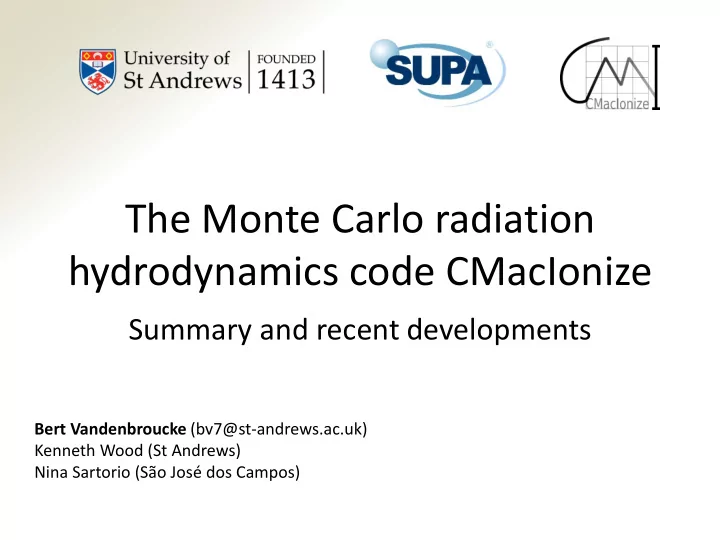

The Monte Carlo radiation hydrodynamics code CMacIonize Summary and recent developments Bert Vandenbroucke (bv7@st-andrews.ac.uk) Kenneth Wood (St Andrews) Nina Sartorio (São José dos Campos)
Slide 2 of 16 Photoionization WHAM survey (2003) NGC 604 HST, 1995
Slide 3 of 16 The problem We need to solve 𝑜 𝑌 𝑗 𝐽 𝑌 𝑗 →𝑌 𝑗+1 = 𝑜 𝑌 𝑗+1 𝑜 𝑓 𝛽 𝑌 𝑗+1 →𝑌 𝑗 𝑈 to obtain equilibrium temperatures and ion densities 𝐽 𝑌 𝑗 →𝑌 𝑗+1 is the total ionizing intensity 𝛽 𝑌 𝑗+1 →𝑌 𝑗 𝑈 is the total recombination rate These equations are highly non-linear; the ionizing intensity is non-local
Slide 4 of 16 The solution ∞ 4𝜌𝐾 𝑗 𝜉 𝐽 𝑗 = න 𝜏 𝜉 d𝜉 ℎ𝜉 𝜉 𝑢 𝑅 Regular (or AMR) grid ≈ 𝑥 𝑘 𝑚 𝑗𝑘 𝜏 𝜉 𝑘 𝑋 𝑢 𝑊 𝑗 𝑘 Vandenbroucke & Wood (2018) Voronoi grid
Slide 5 of 16 The solution (2) Iteratively repeat until convergence (takes approx. 10 iterations)
Slide 6 of 16 The design Modularity: • different grid types User-friendliness: • different source types • explicit use of units • different spectra • class structure maps to • different physics parameter file • ... • extensive documentation • library functionality Reproducibility: • (automated) unit tests Vandenbroucke & Wood (2018) • extensive logging • benchmarks • public ly available https://github.com/bwvdnbro/CMacIonize
Slide 7 of 16 Example: turbulent HII regions Uniform HII region Turbulent HII region based on Wood et al. (2013), Vandenbroucke & Sartorio ( in prep. )
Slide 8 of 16 Example: spectrum tracking All radiation No diffuse Spectral hardening at work based on Wood & Mathis (2004), Vandenbroucke & Sartorio ( in prep. )
Slide 9 of 16 Example: escape fraction Vandenbroucke & Sartorio, in prep. Radiation escaping from turbulent HII clouds is softer than radiation escaping from a uniform cloud
Slide 10 of 16 Example: SILCC(2) H α emission Vandenbroucke et al. (2018)
Slide 11 of 16 RHD simulations Update Convert density Do Monte Carlo pressure based Do hydro step field to number photoionization on ionization density field structure 𝑈 = 𝑈 𝑜 𝑦 𝐼 + 𝑈 𝑗 1 − 𝑦 𝐼 𝑈 𝑜 = 500 K 𝑈 𝑗 = 8,000 K Vandenbroucke & Wood (2018) Harder than it sounds!
Slide 12 of 16 Example: photoionization in DIG Ionising luminosity per source Vandenbroucke & Wood (submitted to MNRAS)
Slide 13 of 16 Example: ionized accretion torus Sartorio et al. (2019)
Slide 14 of 16 Example: turbulent clouds Sartorio & Vandenbroucke, in prep.
Slide 15 of 16 The future: PMacIonize Vandenbroucke & Wood (2018) CMacIonize 2.0
Slide 16 of 16 Summary • Do you have sources of ionising radiation? • Do you want to know how they ionise their surroundings? • Do you want to know how ionisation affects the dynamics of their surroundings? • Consider using ! Vandenbroucke & Wood (2018) https://github.com/bwvdnbro/CMacIonize
Recommend
More recommend